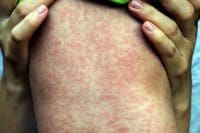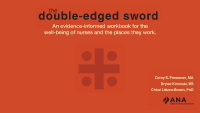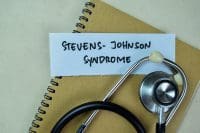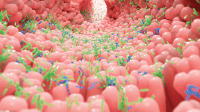You reverse an overdose in the community.
Takeaways:
- Opioid use disorder can be seen in hospitals, outpatient clinics, and even in the community.
- Bystander naloxone administration is an opportunity to treat victims of opioid overdose in non-acute settings.
- Nursing assessment and priority actions can help reduce opioid use disorder.
It’s your day off and you’re running errands. You stop for coffee at a local café and start chatting with friends. After about 15 minutes, you overhear another patron tell the manager that a man has been in the restroom “for a long time and he isn’t answering when I knock.” After the manager knocks on the locked door and gets no answer, she unlocks it. As soon as the manager opens the door, she yells, “Call 911, this man has passed out!”
Assessment findings
You identify yourself as an RN and ask if you can help. The manager shows you a young man, who is face down on the floor, unresponsive, with emesis on his face. You also note a rubber strap tied around the man’s left bicep and a needle and syringe lying next to him, leading you to suspect a potential I.V. drug overdose.
Taking action
Knowing that the man could have recurrent episodes of emesis with a high risk for aspiration, you move him into the lateral recovery position and ask the manager about emergency medical equipment. She brings an automated external defibrillator (AED) and a first-aid kit with a pocket ventilation mask.
After you note apnea and cyanosis, but the presence of a pulse, you clear the man’s airway, turn him on his back, and deliver rescue breaths—10 to 12 per minute (one breath every 5 to 6 seconds), per American Heart Association recommendations. Bilateral chest rise indicates adequate ventilation, and the AED isn’t needed because the man has a pulse.
You live in a jurisdiction with standing orders for bystanders to administer naloxone for actual or suspected opioid overdose in the community.* You recently completed training on administering naloxone in the community, and you carry an emergency administration kit in your car. You ask the manager to get the kit while you continue to provide rescue breaths.
The manager returns with the kit, which includes two prepared 4-mg intranasal naloxone doses. The kit’s manufacturer instructs users to deliver a dose by gently placing the nozzle in a patent nostril and pushing the plunger in completely. After administering the naloxone, you resume rescue breaths while observing for signs of the medication’s effect. The desired response to this medication is a return of spontaneous ventilation. Because you know from your training that a potential side effect of naloxone can be confusion or combativeness, you position yourself near the exit so you can leave the room quickly if necessary.
Outcome
Shortly after the naloxone is administered, the man begins to move his extremities and breathe spontaneously, and his facial color becomes pale-pink. The man tries to speak but his speech is slurred and he can’t answer any questions. You reassure him that help is on the way while you continue to monitor his respiratory and neurologic status until emergency medical services (EMS) arrives.
Education and follow-up
After EMS arrives, you report the amount and time the naloxone was given. After some initial hesitation by the man who overdosed, he’s transported to the local emergency department (ED) for evaluation. He should be evaluated to determine if additional doses of naloxone are warranted, and, if indicated and available, treatment for opioid use disorder should be initiated in the ED with referral for ongoing treatment.
A life-threatening opioid overdose can be reversed. Thanks to your assessment and intervention, this man in need has the opportunity to make a recovery.
*Review local laws related to naloxone administration.
John T. Taylor is an associate professor at West Chester University in West Chester, Pennsylvania, and a clinical nurse at Children’s Hospital of Philadelphia.
References
American Heart Association. Highlights of the 2015 American Heart Association Guidelines Update for CPR and ECC. 2015. eccguidelines.heart.org/wp-content/uploads/2015/10/2015-AHA-Guidelines-Highlights-English.pdf
American Society of Addiction Medicine. The ASAM National Practice Guideline for the Use of Medications in the Treatment of Addiction Involving Opioid Use. 2015. asam.org/docs/default-source/practice-support/guidelines-and-consensus-docs/asam-national-practice-guideline-supplement.pdf
Cadet MJ, Tucker L. NP role in medication-assisted treatment for opioid use disorder. Am Nurse Today. 2019;14(1):8-13.
Chimbar L, Moleta Y. Naloxone effectiveness: A systematic review. J Addict Nurs. 2018;29(3):167-71.
Davis CS, Carr D. Legal changes to increase access to naloxone for opioid overdose reversal in the United States. Drug Alcohol Depend. 2015;157:112-20.
Graves RL, Andreyeva E, Perrone J, Shofer FS, Merchant RM, Meisel ZF. Naloxone availability and pharmacy staff knowledge of standing order for naloxone in Pennsylvania pharmacies. J Addict Med. 2019;13(4):272-8.
Mitchell KD, Higgins LJ. Combating opioid overdose with public access to naloxone. J Addict Nurs. 2016;27(3):160-79.
Substance Abuse and Mental Health Services Administration. SAMHSA Opioid Overdose Prevention Toolkit. HHS Publication No. SMA18-4742. June 2018. store.samhsa.gov/product/Opioid-Overdose-Prevention-Toolkit/SMA18-4742


















